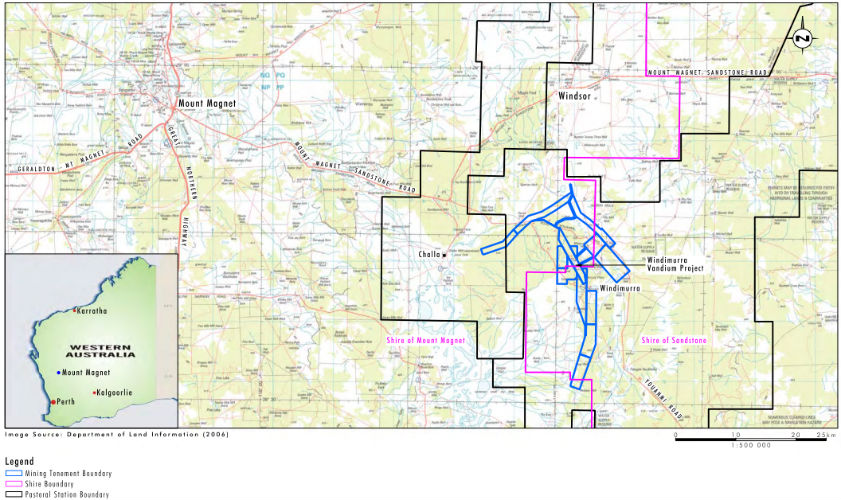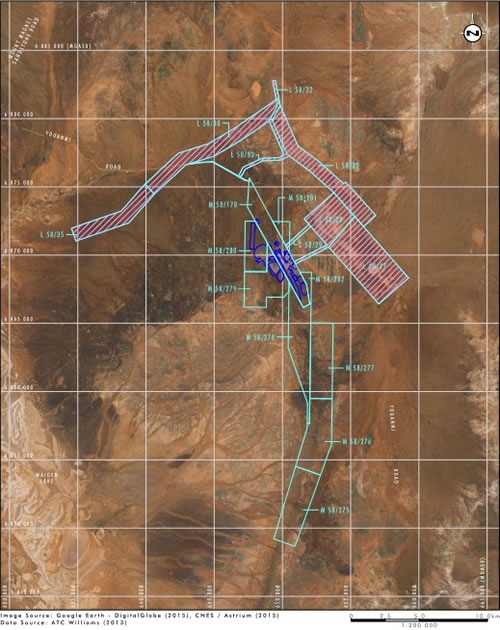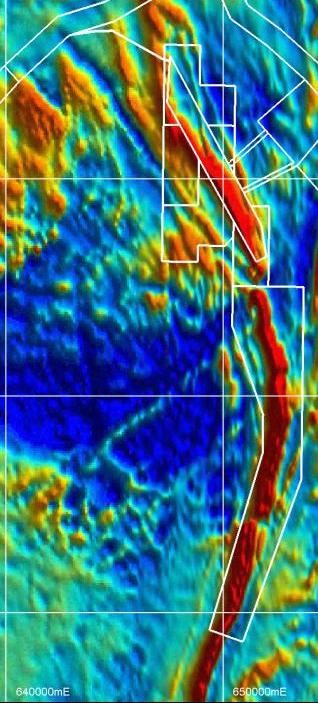Geology, Reserves and Resources
Geology
The Windimurra vanadium deposit is hosted within the Shepherd's Discordant Zone (SDZ), which is part of the Windimurra complex. The SDZ is characterised by magnetite and magnetite-bearing gabbro, which is a transgressive sill like body extending over a strike length of 45 kilometres and having a thickness ranging from 500 metres to 600 metres. It is up to 1 kilometres wide at surface. The magnetite is titano-magnetite containing 10% to 20% TiO2 as ilmenite.
The Project is located in the north of the SDZ in the Hawkstone Ridge and Shepherd's Hill areas that show progressive upwards fractionation consisting of anorthositic magnetite gabbro and numerous magnetite layers and lenses from 5 centimetres to 2 metres thick. The lower 150 metres of this succession contains the vanadium deposit.
The regional location of the Windimurra deposit and associated tenements is shown below.

The vanadium titanomagnetite (VTM) bearing gabbro is deeply weathered down to about 50 metres below the present surface. From fresh rock, weathering passes upwards through a zone of saprock up to 5 metres thick, into saprolite (30 metres to 40 metres thick), then to a mottled clay zone 3 metres to 10 metres thick. A lateritic caprock up to 5 metres thick has largely been eroded except in the vicinity of Hawkstone Ridge. The base of complete oxidation is about 30 metres below surface.
The magnetite-bearing gabbro is more susceptible to weathering than the magnetite. Fibrous and spotty goethite appears from the weathering of magnetite and other iron-bearing minerals occurring along fractures and grain boundaries. Ilmenite remains relatively unaffected, apart from a textural change from the trellis-like lamellae to granular and rounded blebs.
Mineralisation
Most of the vanadium mineralisation is VTM-bearing gabbro and leucogabbro in a broadly continuous layered sequence varying in thickness from 20 metres to 80 metres.
The VTM forms large granular aggregates up to 5 millimetres wide, inter-grown with lenticular bodies of silicate minerals. The VTM is mainly composed of magnetite that can contain up to 30% by volume of ilmenite inter-growths derived from exsolution. The ilmenite occurs as fine-grained lamellae within fresh magnetite, with up to 10% as coarser, blebby inter-growths (<2 millimetres diameter) in weathered magnetite.
Ilmenite may contain up to 0.5% V2O5 and some pyrite contains up to 0.1% V2O5. Pyrite makes up to 1% of the volume of fresh rock. Other minor sulphides present are pentlandite, pyrrhotite, chalcopyrite and violarite.
Mineral Resources
The Windimurra mineral resource estimate is based on a 6 kilometre strike length and was reported in 2019. The total resource is 209.7 million tonnes at 0.50% V2O5, using a lower cut-off of 0.28% V2O5.
Below is a typical cross section showing the layout of the principal geological domains at Windimurra.

Typical Cross Section Displaying Lithological Units and Corresponding Domains
Mineral Resources - Windimurra Vanadium Project (at a 0.28% V2O5 cut-off)
|
|
November 2019
|
|
Classification
|
Tonnes
(Mt)
|
V2O5
(%)
|
|
Measured
|
34.6
|
0.49
|
|
Indicated
|
123.5
|
0.50
|
|
Inferred
|
51.6
|
0.50
|
|
TOTAL
|
209.7
|
0.50
|
Ore Reserves
The ore reserve base of the project is based on an ore reserve estimate from an optimised 4.7 kilometre core of the resource base reported in 2019. The total ore reserve is currently 87.5 million tonnes at 0.49% V2O5, using a lower cut-off of approximately 0.3% V2O5.

Overall Pit Layout Plan
November 2019 Ore Reserves
|
Classification
|
Tonnes
(Mt)
|
V2O5
(%)
|
|
Probable
|
87.5
|
0.49
|
|
TOTAL
|
87.5
|
0.49
|
Exploration
The Windimurra project includes a package of 100% owned mining tenements covering a total strike length of 27 kilometres of prospective ground for titano-vanadium and magnetite based iron ore-style mineralisation. The current mineral resource is based on the northern 6 kilometre corridor within the 27 kilometre strike. This leaves an extensive 21 kilometre strike package unexplored to the south.

Tenement Map Showing Significant Mining Lease Holdings
A high resolution aero-magnetic response survey was undertaken over the ground in 2007, with further detailed fill-in lines undertaken in 2008. The responses showed that the high magnetic gabbros associated with the lower layered sequence of the SDZ, which hosts the titano-vanadium horizon at Windimurra, extends through the southerly tenement holdings.
Exploration of the region has a limited history, with several companies undertaking low level reconnaissance surveys (Hawkstone Minerals and Ferrovanadium Corp in the 1970's and early 1980's, an Alcoa Australia and BHP Minerals Joint Venture in the mid-1980's and Precious Metals Australia in 1989). All exploration and resource development works were undertaken within the northern 6 kilometre strike length that now forms the Windimurra vanadium mine.

Aeromagnetic Signature - Windimurra Southerly Extensions
First exploration on the southern strike was initiated in January 2011, via 5 traverse lines of reverse circulation drilling, 5 kilometres apart, across the high magnetic signature.
This scout drill program was not designed nor intended to return a quantifiable mineral resource, but to be used as a tool in confirming the overall geological setting and weathering states, and to return an understanding into the broad V2O5, Fe and TiO2 grade distributions within the belt. As such, it was designed as a preliminary stepping stone in the development of a future targeted strategy for these tenements.
The scout program was successful in confirming the continuous presence of the main vanadium-magneto horizon as expressed in the SDZ at Windimurra, for the strike length of the southerly tenement holdings. Widths of mineralisation and grades of vanadium bearing units were comparable to Windimurra for the first 9 kilometres south of the proposed current life of mine pit design, and then reduced to approximately half the width by the time the southern extent was reached. Importantly, the vanadium grade was maintained.

3D of Aeromagnetic Signature with Drill Lines
Atlantic is committed to future systematic exploration of this highly prospective southern extension of the known Windimurra deposit. Future programs will include follow up exploration and definition of resources based on the previously identified 0.80% V2O5 massive magnetite hosted beds that outcrop.
Competent Person Statement
Mineral Resources and Exploration Activities
The information in this report relating to Exploration Activities and Mineral Resources is based on information prepared by Snowden in 2019 and complies with the JORC Code 2012.
Ore Reserves
The information in this report that relates to the mining aspects of the Ore Reserves is based on information compiled under the direction of Mr Frank Blanchfield. Mr Blanchfield is a Fellow of the Australasian Institute of Mining and Metallurgy (AusIMM) and is employed by Snowden. Mr Blanchfield has experience relevant to the type of deposit under consideration to qualify as a Competent Person as defined in the JORC Code 2012. Mr Blanchfield visited the site in December 2019.
The information in this report that relates to Ore Reserves is based on information compiled under the direction of Dr Ian Ritchie. Dr Ritchie is a Member of the Australasian Institute of Mining and Metallurgy (AusIMM) and is employed by Atlantic Vanadium Pty Ltd. Dr Ritchie has experience relevant to qualify as a Competent Person as defined in the JORC Code 2012. Dr Ritchie visited the site between May 2018 and December 2019.